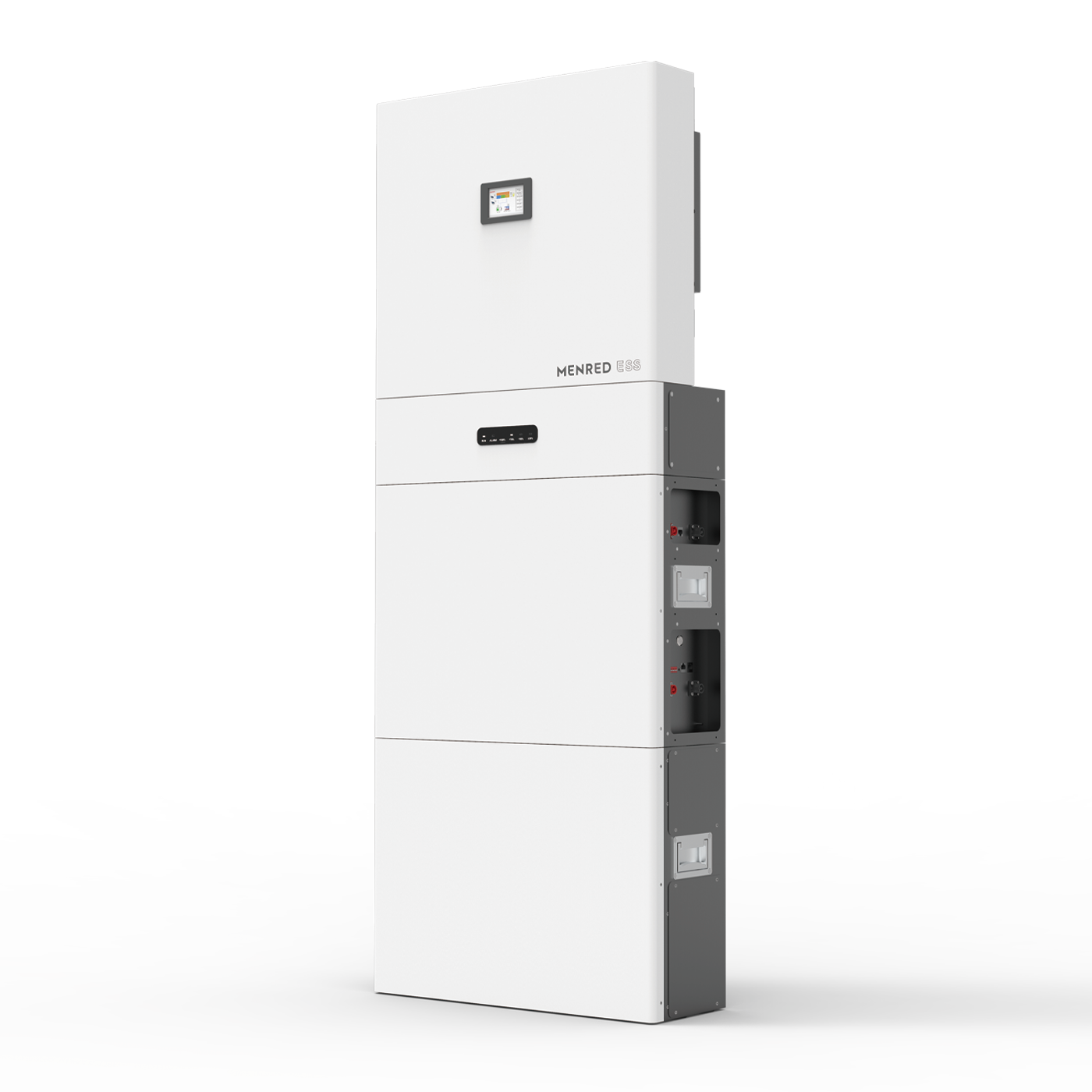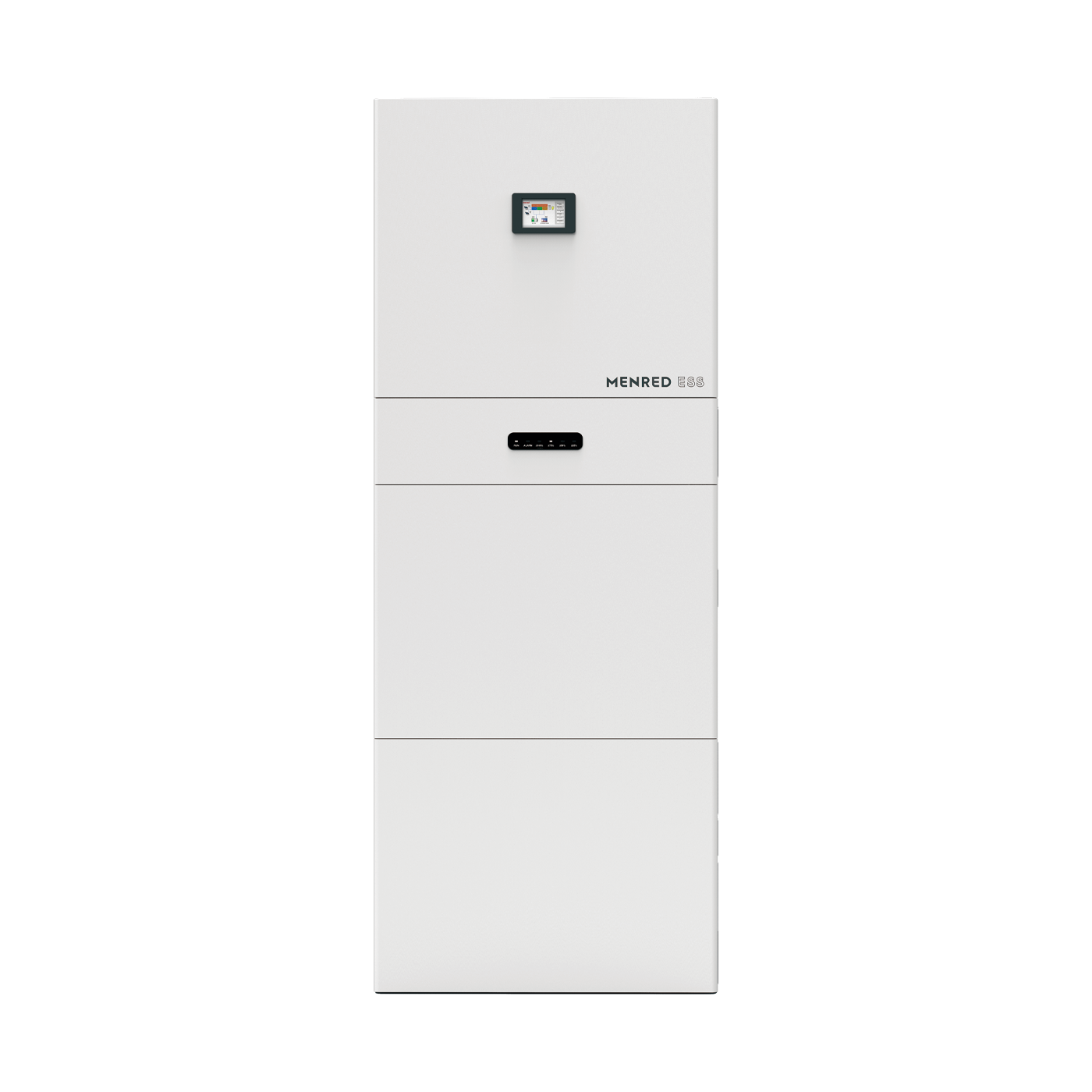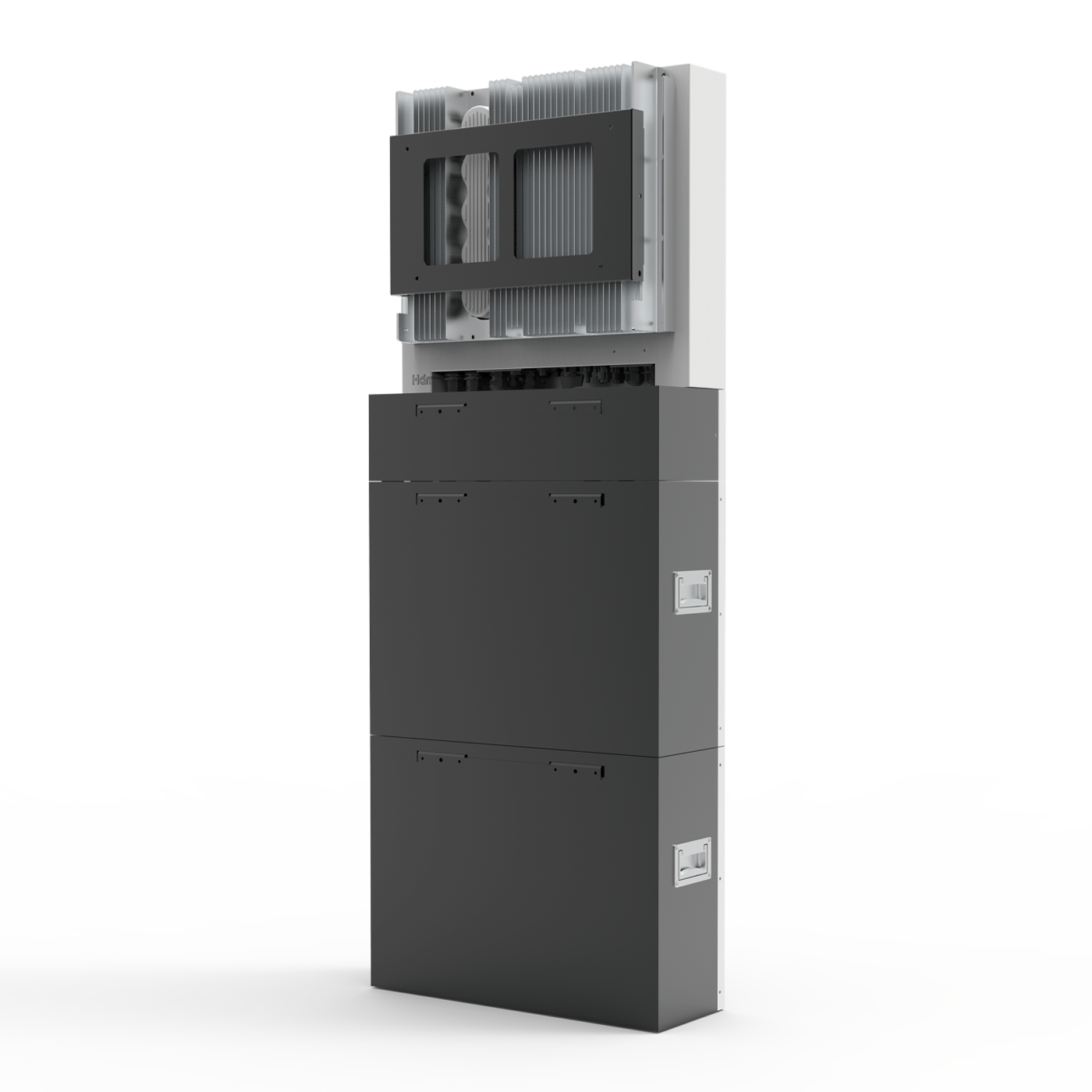Description
ESS .RL1 .612 RESIDENTIAL ESS
• The ESS.RL1.612 integrated photovoltaic energy storage system features a high solar input of up to 7kW, a 6kW UPS uninterruptible power supply output, and off-grid functionality.
• Its standard configuration includes the LFP.6144.G2 energy storage system with a capacity of up to 12.28kWh.
• The inverter system can be parallel connected up to 4 units to form a single-phase 24kW system or 3 units to form an 18kW three-phase system .
• A single system can be combined with a maximum of 92.16kWh
energy storage system.

The MENRED ESSApp is compatible with both iOS and Android platforms. It supports residential energy storage systems, lithium batteries, as well as commercial and industrial energy storage systems *

• Intelligently managing solar power generation, this system provides limited supply for residential loads, stores the surplus energy in batteries, and flexibly configures the excess energy to the grid once the batteries are fully charged. It can be expanded up to a maximum capacity of 85.96KWH.
• The user-friendly human-machine interface allows for a clear understanding of the system’s operational status.
• Local warehousing and logistics services are available in Germany, supporting bulk orders from trading companies.
• Supports mobile APP for viewing the system’s operating status, compatible with both Android and iOS systems.
•The equipment installation can be adapted to complex environments according to the user’s specific needs and scenarios.

Hybrid Inverter(ON/OFF Grid)
· The system has a 7kW photovoltaic input and a 6kW uninterruptible power supply output.
· It features automatic switch between grid-connected andoff-grid modes, self consumption, power shift, and battery priority working modes.
· The system allows flexible configuration, with the ability to parallel connect up to four units for a total output of 24kW or three units for an 18kW three-phase system. It also supports connection with a diesel generator.
· It comes with a 4.3-inch touch LCD screen and standard built-in WiFi functionality. It has a complete EMS management system and supports iOS and Android apps.
Battery Parallel Control Box
· The Battery Parallel Control Box is equipped with a built-in BMS (Battery Management System) main control module. The data from the parallel-connected battery modules is sent to the main control module for centralized control. It communicates with the inverter through the CAN (Controller Area Network) protocol.
· It supports a maximum of 8 parallel-connected battery modules, with the option to expand the capacity up to 49.15kWh. It also features passive balancing functionality, ensuring that each battery module operates in the optimal state to achieve optimal performance.
· The Battery Parallel Control Box supports a maximum of 4 systems parallel connection, with a total capacity that can reach up to 196.6kWh.
LiFePO4 Battery Module
· The A-grade battery cells used in the Battery Parallel Control Box support 1C charge and discharge rates. These lithium iron phosphate (LiFePO4) batteries have a cycle life of over 6000 cycles at 25 degrees Celsius and 0.5C discharge rate. They are known for their safety features, as they are non-flammable and non-explosive.
· The built-in BMS includes over 115 fault sensing functions, ensuring the safety and reliability of the battery system. Each individual module also has passive balancing functionality to ensure the consistent performance of the battery cells.
· The Battery Parallel Control Box is designed with a special structure that allows easy parallel connection and communication between battery modules.
· It is designed to be both wall-mounted and stackable, providing flexibility in installation options.
Inverter Parameters
| Inverter Type | on/off grid(hybrid) | |||||
| Max PV Input Power | 7000W | |||||
| Max PV Input Current | 14A | |||||
| Max PV Input Voltage | 550Vdc | |||||
| PV Input Voltage Range | 120-500Vdc | |||||
| Full-load Voltage Range | 220-500Vdc | |||||
| Circuits/Maximum Number Of Parallel Per Circuit | 2/1 | |||||
| Inverter Maximum Feedback Current To Array | 0 | |||||
| MPPT Efficiency/European Efficiency | 99.9%/97% | |||||
| Max Discharge/Charge Current | 110A/95A | |||||
| Rated Grid Input/Output Voltage Range | 230Vac(176-270Vac) | |||||
| Rated Frequency | 50HZ/60HZ | |||||
| Max Grid Input/Output Current | 26A | |||||
| Off-grid Mode Power Ratings | 6000W/VA | |||||
| Battery Charge/Discharge Efficiency | 95% | |||||
| THDi&THDv | <3%&<2% | |||||
| Transfer Time | <20ms | |||||
| System Parallel | Up to 4 units | |||||
| Power Factors | 0.99 Leading~0.99 Lagging | |||||
| Communication Protocols | CAN/RS485/LAN/DRM | |||||
Battery Speciffications
| Rated Battery Voltage | 51.2V | |||||
| Standard Configuration Capacity | 12.28kWh | |||||
| Battery And Inverter Communication Protocols | CAN | |||||
| Battery Operating Voltage | Follow BMS SOC,DOD 90%(Adjustable) | |||||
| Battery Parallel | Max 8 units in parallel to 49.12kWh | |||||
| Battery Cluster Parallel | MAX 4 group in parallel to 196.4kWh | |||||
| Cycle Life | >6000times@25℃&0.5C | |||||
| Max Output Current | 120A | |||||
| Safety Certification | IEC62109,IEC62477 | |||||
| CE-EMC | IEC/EN61000-6-1/6-3 | |||||
| Grid Connection License | EN50549-1/G98/G99/CEI0-21/VDE4105 | |||||
ESS.RL1.612
THE WORKING MODE AND PRINCIPLE OF A PHOTOVOLTAIC ENERGY STORAGE SYSTEM
The ESS.RL1.612 photovoltaic energy storage system has three selectable operating modes: self-consumption, power shift, and battery priority.
Self Consumption Mode

In Scenario ①:
The photovoltaic system, grid power, and battery are all functioning normally.
A. In this scenario, the photovoltaic system is prioritized to supply electricity to household appliances. If there is any surplus energy, it will be used to charge the battery. However, if the battery is already fully charged or if the charging power exceeds the maximum limit, the excess energy will be fed back into the grid.
B. In this scenario, the photovoltaic system is again prioritized to supply electricity to household appliances. If the solar power generation is not sufficient to meet the power demand of the appliances, the battery will compensate for the shortfall by discharging its stored energy.
C. Once again, the photovoltaic system is given priority to supply electricity to household appliances. If both the solar power generation and battery discharge are still insufficient to meet the power
demand, the remaining shortfall will be supplemented by drawing electricity from the grid.

In Scenario ②:
The photovoltaic system and battery are functioning normally, but there is a power outage or malfunction in the city’s power grid.
A. The photovoltaic system prioritizes supplying electricity to household appliances. If there is any surplus energy, it will be used to charge the battery. However, once the battery is fully charged, the photovoltaic system will limit its generation to only meet the power demand of the household appliances.
B. The photovoltaic system continues to prioritize supplying electricity to household appliances. If the power generated by the photovoltaic system is not sufficient to meet the power demand, the system will then draw power from the battery to supplement the shortfall and ensure a continuous power
supply to the appliances.

In Scenario ③:
The battery has failed, but both the photovoltaic system and the city’s power grid are functioning normally
A. The photovoltaic system prioritizes supplying electricity to household appliances, and any surplus energy will be integrated into the power grid.
B. The photovoltaic system prioritizes supplying electricity to household appliances. If the power generated is insufficient, the system will supplement the shortfall by drawing electricity from the grid.ry to supplement the shortfall and ensure a continuous power
Power Shift

In Scenario ①:
The photovoltaic system, grid power, and battery are all functioning normally.
A. During the designated charging time, the photovoltaic system prioritizes charging the battery. If there is excess energy available, it is used to power household appliances. If there is still surplus energy, it is integrated into the power grid.
B. During the designated charging time, the photovoltaic system prioritizes charging the battery. Excess
energy is used to power household appliances. If the power generated by the photovoltaic system is not sufficient to meet the power demand, the grid supplies electricity to the battery while also charging it.
C. During the designated discharging time, the photovoltaic system prioritizes supplying electricity to
household appliances. If there is still surplus energy generated by the photovoltaic system, it is integrated into the power grid.
D. When the system is not in the charging or discharging period, the photovoltaic system prioritizes supplying power to the load. Excess energy is integrated into the power grid.

In Scenario ②:
Grid power and battery are functioning normally, while there is no solar power generation or a solar power system failure.
A. During the designated charging time, the grid power supplies electricity to household appliances while also charging the battery.
B. During the designated discharging time, if the battery has sufficient energy, it supplies power to household appliances. Any excess energy is integrated into the power grid or used to power other household appliances connected to the meter.
C. During the designated discharging time, if the power requirement of household appliances exceeds the output power of the battery, both the grid power and the battery work together to supply power to household appliances.
Battery Priority

In Scenario ①:
The photovoltaic system, grid power, and battery are all functioning normally.
A. Photovoltaic generation prioritizes charging the battery. When there is excess energy available, it is used to power household appliances. If there is still surplus energy, it is integrated into the grid.
B. Photovoltaic generation prioritizes charging the battery. When there is excess energy available, it is used to power household appliances. If the photovoltaic generation is unable to meet the demands of both
charging the battery and powering household appliances, the grid power is responsible for supplying power to the loads.

In Scenario ②:
Grid power and battery are functioning normally, but the photovoltaic system is disconnected or experiencing a fault.
While supplying power to household appliances, the grid power also charges the battery.





Reviews
There are no reviews yet.